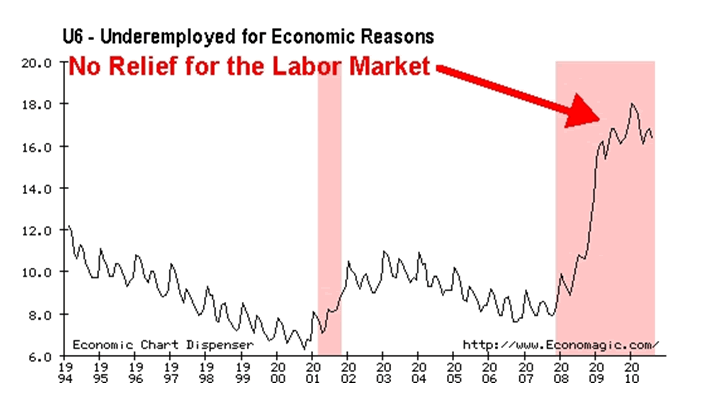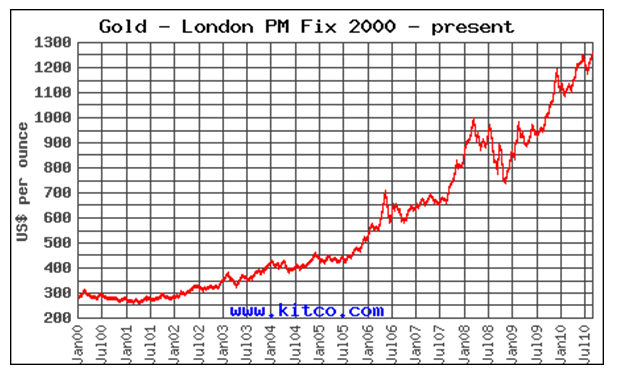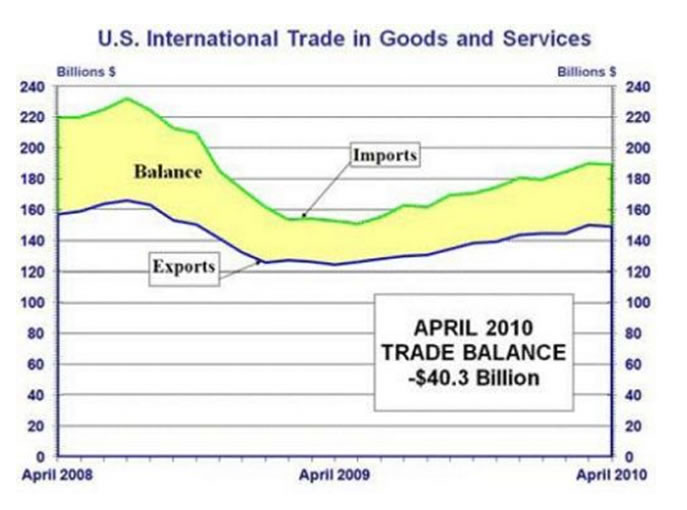Meet the New Goldilocks Economy
Economics / US Economy Sep 10, 2010 - 02:38 PM GMTBy: Andy_Sutton
 Back in the glory days of 2008, the mainstream press, political pundits, and various government officials talked about the idea of the Goldilocks economy. Not too hot, not too cold, but just right. Of course the analogy ended when the bears chased Goldilocks out of the cottage. While the same outlets aren’t trotting out the fairy tale this time around, it is clear that the US has hit phase two of the Goldilocks economy and it is my guess that most folks will like this one even less than the first.
Back in the glory days of 2008, the mainstream press, political pundits, and various government officials talked about the idea of the Goldilocks economy. Not too hot, not too cold, but just right. Of course the analogy ended when the bears chased Goldilocks out of the cottage. While the same outlets aren’t trotting out the fairy tale this time around, it is clear that the US has hit phase two of the Goldilocks economy and it is my guess that most folks will like this one even less than the first.
And again, there are three major bears that are threatening to once again drive Goldilocks deep into the forest.
Bear #1 – A Jobless Economy
Month after month, the Bureau of Labor Statistics releases Employment Situation reports that continue to befuddle even the most casual of observers. They have become Newspeak in the truest sense of the word. Take last Friday’s report for example.
BLS reported that 54,000 jobs had been lost in August. The media immediately jumped on the fact that private sector payrolls were up by 67,000 and immediately blamed the entirety of the negative report on the fact that it was only bad because some census workers got laid off. Talk about having your cake and eating it too. Back in the spring when the census workers were being hired, it was the same press that counted those temporary jobs as if they were actually created by a recovering economy.

But it actually goes a lot deeper than just the 67,000 jobs gained in the private sector. Let’s analyze:
331,000 people became underemployed for economic reasons, meaning that they desired full time work, but were only able to find part time work. 331,000 full-time jobs lost. That takes out total up to 385,000. Left completely uncounted are those folks who lost one full time jobs and managed to find another, but at a much lower wage.
BLS’ CESBD Birth/Death adjustment assumed that 115,000 full-time jobs were created by new businesses in August. This ‘adjustment’ has been a source of great consternation by labor market analysts and real economists for some time now. In what turned out to be a vain attempt at getting a look at the methodology used to derive this number, I contacted BLS and had email communications with no less than a half dozen staff economists in its Continuing Employment Statistics group. Not a single one of them could or would give me any information on how this metric was arrived at other than to point me to the website. At this point, we are left to assume that the Birth/Death adjustment is probably more arbitrary than anything based in reality. So for argument’s sake, let’s back out half of those fictitious jobs. Our total is now at 442,500 full-time jobs lost.

Finally, in order to keep pace with demographics, the economy needs to create 150,000 full-time jobs each month just to break even. Creating that many will not result in a reduction in unemployment but is the working equivalent of treading water.
Taking all this into account, August saw a deficit of 592,500 full-time jobs. And this was carried as a ‘good’ report? Former Labor Secy. Robert Reich actually came out and declared the report in its totality to be ‘awful’.
Keep in mind that the mediocre (at best) and lately awful jobs reports are AFTER nearly a trillion dollars in direct stimulus and over another trillion in palliatives by the Fed in the form of purchasing mortgage-backed securities to stimulate the housing/construction sector. This reality alone should serve to underscore how dire the situation is. Unfortunately, this will likely be the status quo moving forward. Meet the new Goldilocks.
Bear #2 – An Unending Bear Market
It has been a cruel twist that the bear market which has been firmly in place since 2007 came precisely as the baby boomers began having serious thoughts about retirement. There have been countless stories of folks who retired in late 2007 or early 2008, either by choice or because they lost jobs and decided to retire, then had their portfolios halved over the next 18 months.
Sure the markets have recovered somewhat, but so many individual investors bailed out at Dow 8000 to 6500 and never got back in for the upswing. This market certainly has many folks perplexed. This is one of the reasons we have focused nearly exclusively on income producing investments, opting to lock in returns in the present rather than gambling on an uncertain future.
What many still have not realized is that the investing paradigm changed in a big way back in the year 2000. Stocks had seen an 18 year Supercycle of solid gains. One could quite literally pin the Sunday business section up on a wall, throw darts blindfolded and have a better than average chance of picking a winning portfolio. Precious metals languished for nearly two decades. That all changed in 2000 and as we entered a new century, we entered a new paradigm. Gold has surged fourfold and change and stocks have gone absolutely nowhere.

These Supercycles are generally 16, 18, or 20 years, so at a minimum, the current paradigm has another 6 years to go. Given all the distress in the economy from both a macro and fiscal perspective, it is entirely possible that we’re only halfway through this cycle. That means another 6-10 years of the stock market bear and another 6-10 years of strength in precious metals. At least in this case, there is a silver lining – pun intended.
Bear #3 – Leverage in All the Wrong Places
Perhaps the most ferocious of all the bears set to battle this new, unimproved Goldilocks is leverage or lack thereof. We have heard plenty about the leverage in the banking system and how it has been used to enhance bank and brokerage profits over the past few years. We’ve also talked plenty about how leverage has helped destroy the consumer, which is absolutely true. What is not being talked about, however, is the lack of leverage that we have as a nation in terms of righting the ship.
There have been many calls for the US to reassert itself as the premier manufacturing nation in the world. This would serve the dual purpose of diminishing our reliance on foreign goods as well as helping the unemployment situation by bringing jobs home. While I am a huge advocate of doing exactly this, there are several major problems that need to be dealt with along the way should we as a nation decide to pursue this path.

First and foremost is the fact that many American goods are not price competitive with their foreign counterparts simply because of the cost of labor. Placing tariffs on imported goods is an obvious solution proposed by many, but keep in mind the role that just the Chinese have played in keeping our economy afloat over the past decade in particular through vendor financing – the purchase of US debt.
Secondly, shifting manufacturing back to the US would require the rebuilding of the manufacturing infrastructure including the railroads and likely the power distribution grids in many areas as well. This is a huge capital investment and isn’t even on the radar of most policymakers. The mindset isn’t there at this time. For the most part we are content to convert old railways into biking paths instead of trying to figure out how to revive them.
A third area where the US lacks the leverage to reassert herself is in the area of energy. With peak oil on the immediate horizon, we are doing precious little other than burning a lot of corn to prepare for yet another paradigm shift. As long as we’re dependent on foreigners for one of the most important staples of economic growth, we will not be able to affect meaningful changes.
There are other areas as well, but I think the point has been made. A stagnant labor market, lack of individual wealth growth, and a lack of economic and tactical leverage to change key areas are conspiring to create this new Goldilocks economy which will plod along as long as trillions of new dollars are pumped in on a regular basis. Can anyone say unsustainable?
Next week we’ll finish up our analysis of proposed new gasoline taxes from a partial equilibrium perspective.
By Andy Sutton
http://www.my2centsonline.com
Andy Sutton holds a MBA with Honors in Economics from Moravian College and is a member of Omicron Delta Epsilon International Honor Society in Economics. His firm, Sutton & Associates, LLC currently provides financial planning services to a growing book of clients using a conservative approach aimed at accumulating high quality, income producing assets while providing protection against a falling dollar. For more information visit www.suttonfinance.net
Andy Sutton Archive |
© 2005-2022 http://www.MarketOracle.co.uk - The Market Oracle is a FREE Daily Financial Markets Analysis & Forecasting online publication.



